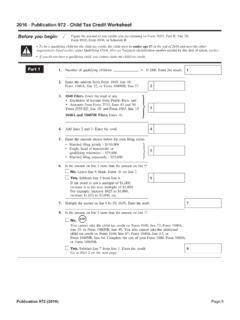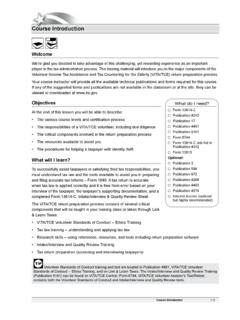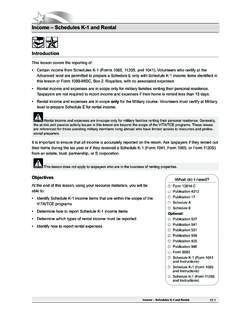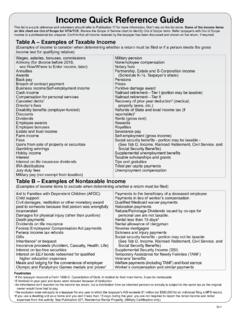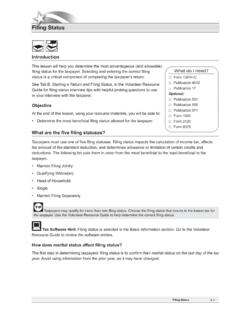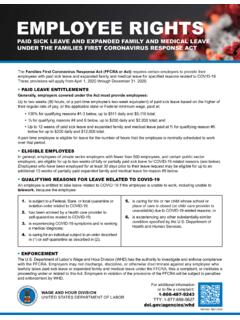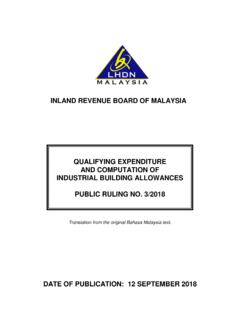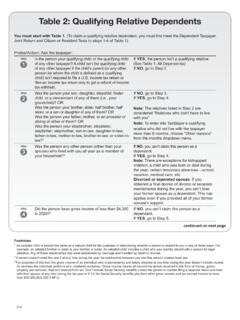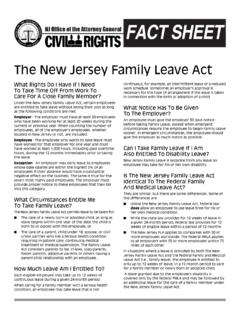Transcription of Table 1: All Dependents - IRS tax forms
1 C-3 Table 1: All Dependents Begin with this Table to determine both qualifying Child and qualifying Relative : Ask the taxpayer:step 1 Can you or your spouse (if filing jointly) be claimed as a dependent on another taxpayer s tax return this year?5If YES: If you can be claimed as a dependent by another taxpayer, you may not claim anyone else as your dependent . If NO: Go to Step 2step 2 Was the person married as of December 31, 2020?If YES: Go to Step 3 If NO: Go to Step 4step 3Is the person filing a joint return for this tax year? (Answer NO if the person is filing a joint return only to claim a refund of income tax withheld or estimated tax paid.)If YES: You can t claim this person as a dependent . If NO: Go to Step 4step 4 Was the person a citizen, resident alien, national, or a resident of Canada or Mexico?
2 (Answer YES if you are a citizen or national and you adopted a child who lived with you as a member of your household all year.)If YES: Go to Step 5 If NO: You can t claim this person as a 5 Was the person your son, daughter, stepchild, eligible foster child, brother, sister, half brother, half sister, stepbrother, stepsister, or a descendant of any of them ( , your grandchild, niece, or nephew)?4If YES: Go to Step 6 If NO: This person isn t your qualifying child. Go to Table 2: qualifying Relative Dependentsstep 6 Was the person: -under age 19 at the end of the year and younger than you (or your spouse, if filing jointly) OR -under age 24 at the end of the year, a full-time student (see definition in the glossary) and younger than you (or your spouse, if filing jointly) OR -any age if permanently and totally disabled1 at any time during the year?
3 If YES: Go to Step 7 If NO: This person isn t your qualifying child. Go to Table 2: qualifying Relative Dependentsstep 7 Did the person live with you as a member of your household, except for temporary absences2, for more than half the year? (Answer YES if the child was born or died during the year.)If YES: Go to Step 8 (Use Table 3 to see if the dependency for children of divorced or separated parents or parents who live apart applies.) If NO: This person isn t your qualifying child. Go to Table 2: qualifying Relative Dependentsstep 8 Did the person provide more than half of his or her own support3 for the year?If YES: You can t claim this person as a dependent If NO: Go to Step 9step 9Is the person a qualifying child of any other taxpayer?If YES: Go to the chart: qualifying Child of More Than One Person If NO: You can claim this person as a qualifying child dependentFootnotes1 A person is permanently and totally disabled if he or she can t engage in any substantial gainful activity because of a physical or mental condition, AND a doctor determines the condition has lasted or can be expected to last continuously for at least a year or can lead to A child is considered to have lived with you during periods of time when one of you, or both, are temporarily absent due to illness, education, business, vacation, military service, institutionalized care for a child who is permanently and totally disabled, or incarceration.
4 In most cases a child of divorced or separated parents is the qualifying child of the custodial parent. See Table 3: Children of Divorced or Separated Parents or Parents Who Live Apart to see if an exception applies. There is an exception for kidnapped children. See Publication A worksheet for determining support is included later in this tab. If a child receives Social Security benefits and uses them toward his or her own support, those benefits are considered as provided by the child. Benefits provided by the state to a needy person (welfare, food stamps, housing, SSI) are generally considered support provided by the An adopted child is treated the same as a natural child for the purposes of determining whether a person is related to you in any of these ways. For example, an adopted brother or sister is your brother or sister.
5 An adopted child includes a child who was lawfully placed with a person for legal An individual is not a dependent of a person if that person is not required to file an income tax return and either does not file an income tax return or files an income tax return solely to claim a refund of estimated or withheld 2: qualifying Relative DependentsYou must start with Table 1. (To claim a qualifying relative dependent , you must first meet the dependent Taxpayer, Joint Return and Citizen or Resident Tests in steps 1-4 of Table 1)Probe/Action: Ask the taxpayer:step 1Is the person your qualifying child or the qualifying child of any other taxpayer? A child isn t the qualifying child of any other taxpayer if the child s parent (or any other person for whom the child is defined as a qualifying child) isn t required to file a income tax return or files an income tax return only to get a refund of income tax YES, the person isn t a qualifying relative.
6 (See Table 1: All Dependents )If NO, go to Step 2 Was the person your son, daughter, stepchild, foster child, or a descendant of any of them ( , your grandchild)? ORWas the person your brother, sister, half brother, half sister, or a son or daughter of any of them? ORWas the person your father, mother, or an ancestor or sibling of either of them? ORWas the person your stepbrother, stepsister, stepfather, stepmother, son-in-law, daughter-in-law, father-in-law, mother-in-law, brother-in-law, or sister-in-law?1If NO, go to Step YES, go to Step : The relatives listed in Step 2 are considered Relatives who don t have to live with you Note: To enter into TaxSlayer a qualifying relative who did not live with the taxpayer more than 6 months, choose Other reasons from the months dropdown 3 Was the person any other person (other than your spouse) who lived with you all year as a member of your household?
7 2If NO, you can t claim this person as a dependent . If YES, go to Step : There are exceptions for kidnapped children; a child who was born or died during the year; certain temporary absences school, vacation, medical care, etc. Divorced or separated spouse. If you obtained a final decree of divorce or separate maintenance during the year, you can t take your former spouse as a dependent . This rule applies even if you provided all of your former spouse s 4 Did the person have gross income of less than $4,300 in 2020?3If NO, you can t claim this person as a YES, go to Step on next pageFootnotes1 An adopted child is treated the same as a natural child for the purposes of determining whether a person is related to you in any of these ways. For example, an adopted brother or sister is your brother or sister.
8 An adopted child includes a child who was lawfully placed with a person for legal adoption. Any of these relationships that were established by marriage aren t ended by death or A person doesn t meet this test if at any time during the year the relationship between you and that person violates local For purposes of this test, the gross income of an individual who is permanently and totally disabled at any time during the year doesn t include income for services the individual performs at a sheltered workshop. Gross income means all income the person received in the form of money, goods, property and services, that isn t exempt from tax. Don t include Social Security benefits unless the person is married filing a separate return and lived with their spouse at any time during the tax year or if 1/2 the Social Security benefits plus their other gross income and tax exempt interest is more than $25,000 ($32,000 if MFJ).
9 C-5 Table 2: qualifying Relative DependentsContinued Probe/Action: Ask the taxpayer:step 5 Did you provide more than half the person s total support for the year?4If YES, you can claim this person as your qualifying relative dependent . (Use Table 3 to see if the exception for children of divorced or separated parents or parents who live apart applies.)If NO, go to Step 6 Did another person provide more than half the person s total support?If YES, you can t claim this person as a NO, go to Step 7 Did two or more people, each of whom would be able to take the dependent but for the support test,together provide more than half the person s total support?If YES, go to Step NO, you can t claim this person as a 8 Did you provide more than 10% of the person s total support for the year?If YES, go to Step NO, you can t claim this person as a 9 Did the other person(s) providing more than 10% of the person s total support for the year provide you with a signed statement agreeing not to claim the dependent ?
10 If YES, you can claim this person as a dependent . You must file form 2120, Multiple Support Declaration, with your NO, you can t claim this person as a qualifying child A worksheet for determining support is included at the end of this Table 3, Children of Divorced or Separated Parents or Parents Who Live Apart, for the exception to the support a child receives Social Security benefits and uses them toward his or her own support, those benefits are considered as provided by the provided by the state to a needy person are generally considered support provided by the state. A proposed rule, on which taxpayers maychoose to rely, treats governmental payments made to a recipient that the recipient uses, in part, to support others as support of the others providedby the recipient, whereas any part of such payment used for the support of the recipient would constitute support of the recipient by a third party.

